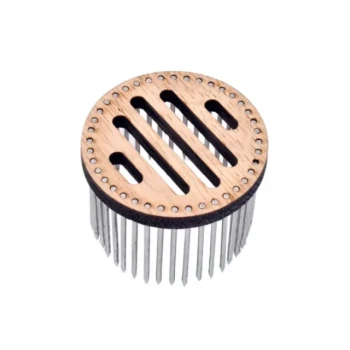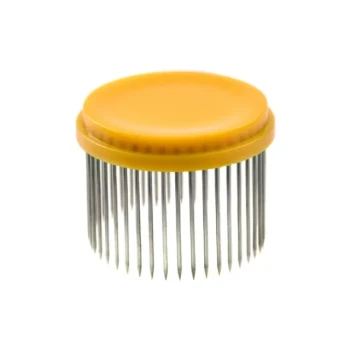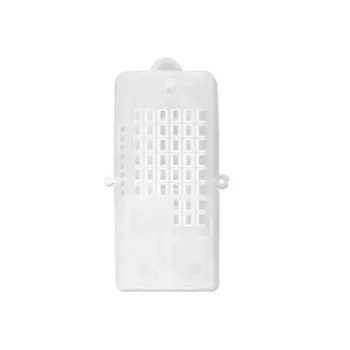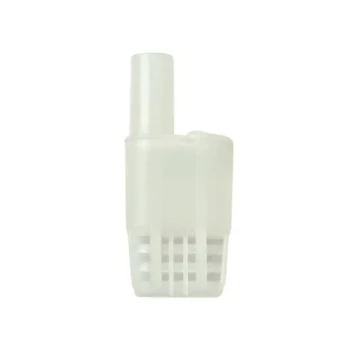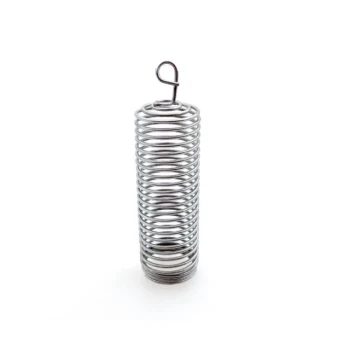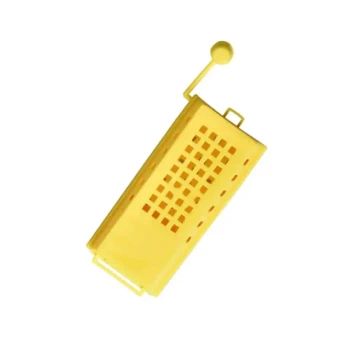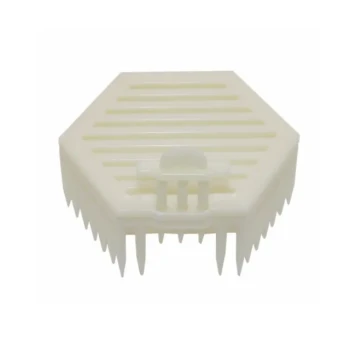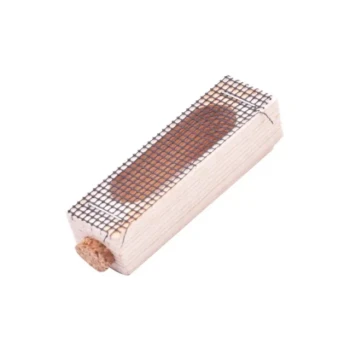To introduce a queen using a push-in cage, you must select a section of comb that contains emerging brood, open cells for laying, and nectar. You then place the queen under the cage, press it firmly into the comb to secure her, and wait one to three days. Once you observe that she has begun laying eggs, you can safely remove the cage and release her into the colony.
The push-in cage method succeeds by leveraging bee biology: it forces close, positive interaction between the new queen and newly emerged bees, who have no prior loyalties. Her egg-laying proves her viability, allowing her pheromones to spread and win over the entire colony before she is fully released.
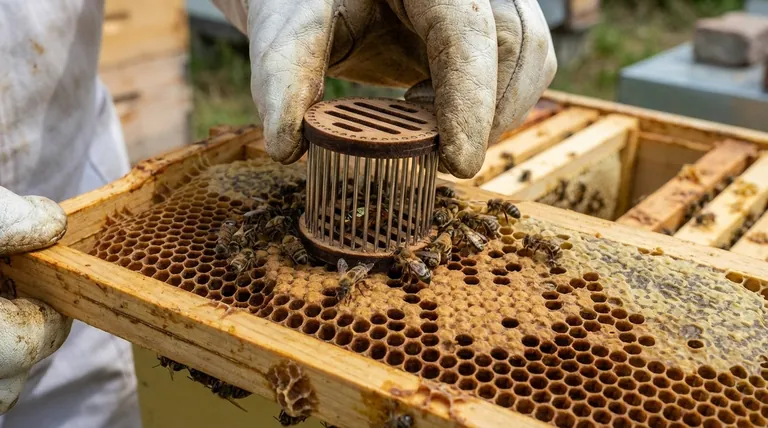
The Principle: Engineering Acceptance
A queen is not accepted because she is physically present; she is accepted because the colony collectively recognizes her as their viable, egg-laying mother. The push-in cage is a tool designed to carefully manage this social and chemical process.
The Power of Emerging Brood
Newly hatched bees are the key. They emerge without allegiance to any previous queen and are hard-wired to care for the first queen they encounter.
By caging the new queen over a patch of emerging brood, you are essentially providing her with a built-in retinue of loyal attendants who will immediately begin to feed her, groom her, and spread her unique pheromones.
Pheromones as a Signal
A queen’s primary tool for colony control is her Queen Mandibular Pheromone (QMP). This chemical signature signals her presence, health, and reproductive status.
The mesh of the push-in cage allows worker bees on the outside to interact with the queen and her new attendants. This facilitates the slow, gradual transfer of her QMP throughout the hive, conditioning the older bees to her presence before they ever come into direct contact.
Step-by-Step Introduction Process
Following these steps methodically maximizes your chances of a successful introduction. This is a delicate operation where preparation is everything.
Step 1: Select the Ideal Comb Location
The section of comb you choose is the most critical factor. It must provide everything the queen needs to establish herself.
Look for a frame that has all three of the following in one area:
- Emerging Brood: Capped cells with pupae that are days, or even hours, from hatching.
- Open Cells: Empty, drawn-out cells where she can immediately begin to lay eggs.
- Food Stores: A few cells of nectar or honey within reach to ensure she and her first attendants are fed.
Step 2: Place the Queen and Cage
Handle the queen with extreme care, ideally by her thorax or legs, never her abdomen.
Place her directly onto the chosen spot on the comb. Immediately cover her with the push-in cage. Press the cage’s edges about half an inch into the comb, ensuring there are no gaps for her to escape or for other bees to enter. A few of her original attendant bees can be placed inside with her.
Step 3: Monitor for the Signal of Acceptance
The ultimate sign of acceptance is seeing the queen fulfill her primary function: laying eggs. This confirms she is comfortable and has been accepted by the bees inside the cage.
Leave the colony undisturbed for one to three days. After this period, perform a quick, quiet inspection. Look for small, white eggs, which resemble tiny grains of rice, at the bottom of the open cells inside the cage.
Step 4: Release the Queen
Once you have confirmed she is laying, you can release her. Gently pull the push-in cage from the comb.
Do not be alarmed if the bees seem to momentarily surround her; this is often curiosity. Observe their behavior for a minute. If there is no aggression (balling or biting), you can confidently close up the hive. The introduction is complete.
Understanding the Trade-offs
The push-in cage is a powerful tool, but it is not always necessary. Understanding its pros and cons helps you decide when to use it.
Advantage: The Highest Success Rate
For introducing particularly valuable queens, or for requeening a colony that is known to be aggressive or has been queenless for a long time, the push-in cage offers the most reliable results. It provides a slow, controlled introduction that is more difficult to achieve with other methods.
Disadvantage: More Labor-Intensive
This method requires more skill and is more intrusive to the colony than using a standard candy-plug introduction cage. It involves finding a perfect spot on a specific frame, manually placing the queen, and performing at least two separate hive inspections (one to place, one to release).
Making the Right Choice for Your Goal
Your choice of introduction method should be based on your specific situation and the level of risk you are willing to accept.
- If your primary focus is safety for a valuable queen: The push-in cage is the superior method for protecting your investment and ensuring acceptance in a challenging situation.
- If your primary focus is a routine, low-risk requeening: A standard introduction cage with a candy plug is often sufficient, less disruptive, and requires less hands-on time from the beekeeper.
By understanding the principles of bee behavior, you can select the right tool to ensure your colony thrives under its new leadership.
Summary Table:
| Step | Key Action | Critical Factor |
|---|---|---|
| 1 | Select Comb Location | Area with emerging brood, open cells, and nectar/honey |
| 2 | Place Queen & Cage | Press cage firmly into comb to secure queen |
| 3 | Monitor for Acceptance | Wait 1-3 days and confirm queen is laying eggs |
| 4 | Release Queen | Gently remove cage after observing egg-laying |
Protect your apiary's productivity with professional-grade equipment from HONESTBEE. As a trusted wholesale supplier for commercial apiaries and beekeeping equipment distributors, we provide the durable, reliable tools you need for successful queen introduction and overall hive management. Let our expertise support your operation's growth and efficiency. Contact our team today to discuss your specific supply needs and discover the HONESTBEE advantage.
Visual Guide

Related Products
- Premium Wood and Steel Push In Queen Cage
- Professional Round Push-In Queen Cage with Metal Tines
- Professional Multi-Functional Queen Bee Cage
- Multi-Function Queen Roller Cage and Catcher
- Wood and Mesh Push-In Queen Cage
People Also Ask
- What are the two main methods of queen introduction? Master Safe & Successful Queen Acceptance
- What precautions should be taken when using press-in cages? Ensure a Safe Queen Introduction
- How does a push-in cage improve queen introduction success? Boost Acceptance with Active Queen Demonstration
- What is a round press-in cage used for in queen marking? A Gentle, On-Comb Marking Method
- What is a push-in queen cage and how does it differ from standard cages? Achieve Higher Queen Acceptance Rates
